Campervan Renter Interview: Camper Van Life-Off The Beaten Path
Sin categorizar, How-To's & Resources, Renter Guest Posts
By Kim Merryman
This summer I’m not as eager to get to the most popular or crowded outdoor attractions. So I’m planning differently in hopes of using the outdoors as an escape not only from home but from other people. My good friends, Christian and Darcy are experts at finding beautiful, remote spots in their campervan named Wayne.
They’ve been living #vanlife for a while now and used to take their adventures in a van named Kokopelli that they purchased from Escape Camper Vans. (Check out their vans’ Instagram account @kokovanlife for tons of #vanlife inspiration.) My boyfriend, Cody, and I interviewed Christian and Darcy to help us plan a safe, off-the-beaten-path summer.
Read our conversation for tips on planning a socially distant trip, essential gear, not getting lost in the middle of nowhere, campervan camping with a newborn, respecting nature, and going to the bathroom in the woods.
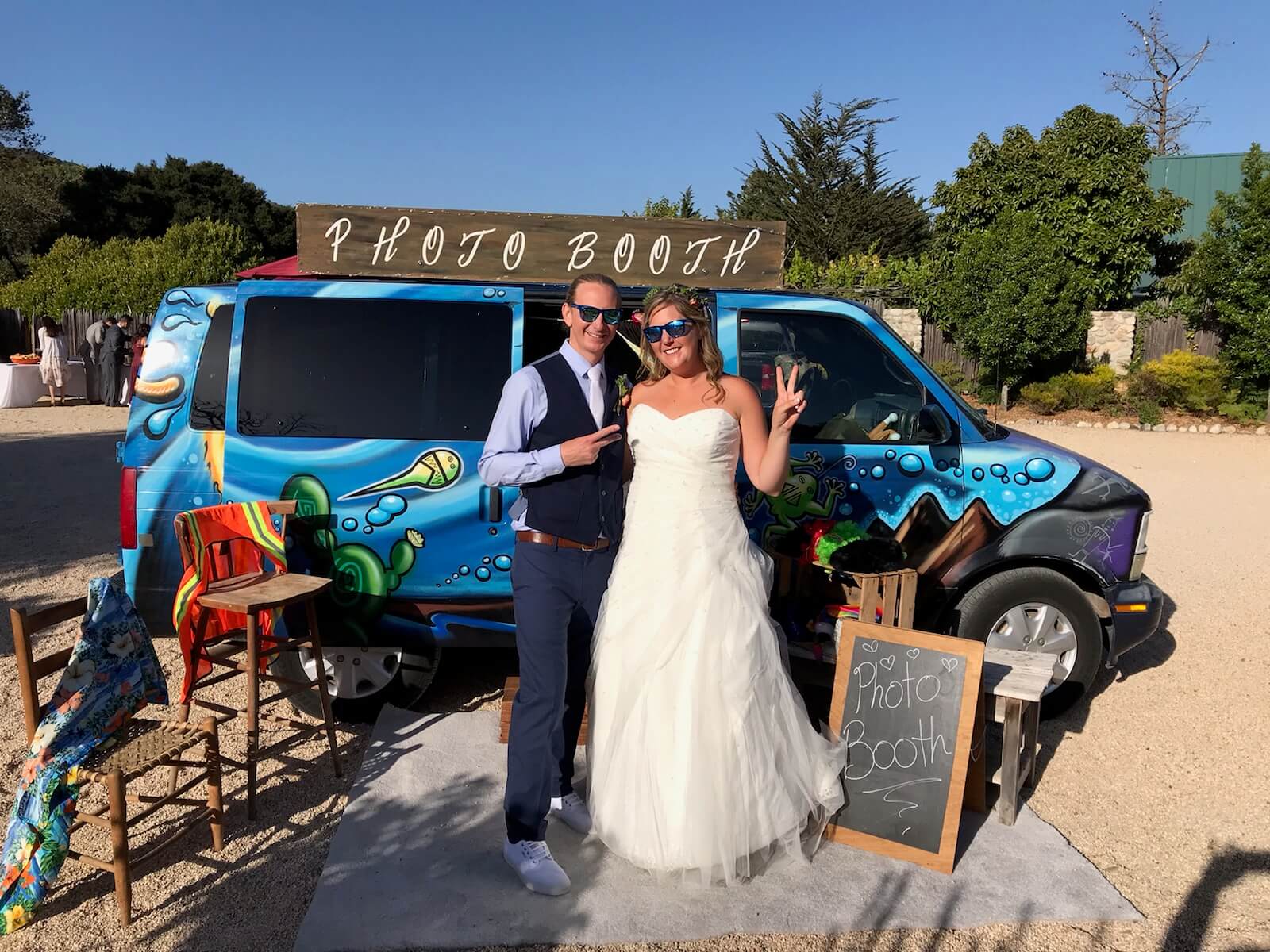
Darcy and Christian used their old Escape campervan as a photo booth at their wedding.
Kim: Tell Escape Camper Vans blog readers a little about yourselves.
Darcy: We’re Christian and Darcy, and we have a newborn baby who’s two months old now. We both really love the outdoors. We live on the Monterey Bay and we’re both teachers so we’re able to travel a lot because we have a lot of time off, especially in the summers. We like to use our van to get outside, and it’s beautiful in California, so we have lots of access to nice places with the van.
Kim: What do you like about van life?
Darcy: Our favorite part about van life is the accessibility to the outdoors with minimal set up.
Christian: It’s like bringing the convenience of home with you into the outdoors. It’s kind of like having a mini home.
Darcy: Yeah we don’t have to pack and unpack. When you’re camping you have to pack your sleeping bag and your air mat and then you have to pack the stove. We don’t have to do any of that. It’s already in the van, set up, ready to go. We just grab our clothes, some food and we go.
Kim: Tell me about your van.
Darcy: Right now we have a 1994 all-wheel-drive Astro Van, with a little bit beefier tires and a small lift. We put a bed and a kitchen into it, and a roof rack and a shower on the roof. We tore out all of the seats and plastic and we put wood on all of the walls and the ceiling. We put in laminate flooring and we built little shelves on the window sills. We put a swivel seat on the front seat, and then we installed a jump seat in the middle so we could bring our newborn baby along and fit his car seat in.
Since we tore out all the other seats in the van, we had to come up with that plan for the baby. The bed folds up into a couch so there’s more space in the van and then it folds down into a full bed. The kitchen has a pump sink with a 5-gallon storage tank under it. We have an auxiliary battery connected to the alternator so the battery charges when we’re driving and it has an inverter so we can plug in our phones, a little mini heater, and the baby bottle warmer.
It just makes it feel a little bit more like home. And we have all the cooking supplies that we just keep in it all the time so it’s easy to cook without having to pack and unpack every time we go on a trip. We also have a big toolbox so if we break down along the road, we can fix the van ourselves, for the most part.
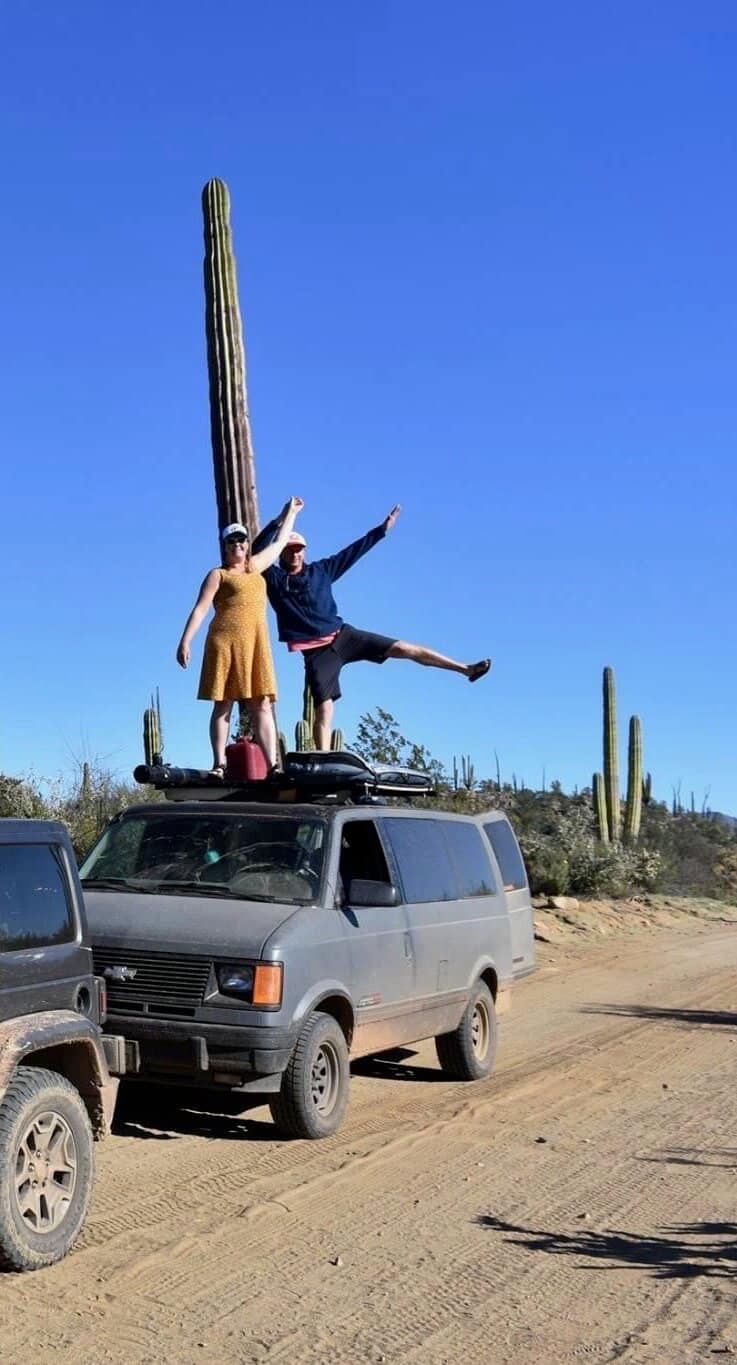
Baja California, Mexico
Kim: What was the first van you purchased?
Christian: The first van we purchased was an old Escape Campervan that they were selling. It was a 1999, 2-wheel drive Astro. We had that for about a year and a half, and we loved it so much, we thought we wanted to upgrade to an all-wheel-drive version.
Kim: When you are planning a trip, how to plan it? How do you approach a trip?
Christian: Well, the first thing we usually do is try to pick a destination, and then once we have a destination in mind, we usually try to figure out some ideal spots along the way. Then once we have our destination and some spots, we look at some other things we need, such as water and food supplies. We plan our gas stops as well and make sure we have everything needed for a successful trip.
Darcy: I think a lot of where we go, we look at the weather and the season and how high the snow line is to make sure that it’s not going to be too hot or too cold where we’re going. So the weather for us makes a really big difference on where we decide to go and what we pack.
Kim: You mentioned you find a destination and some spots along the way. How do you find the spots?
Christian: A lot of it just has to do with being willing to go and explore down roads that you don’t know what’s down there. So you just have to search and find things. Satellite imagery is a great, useful tool.
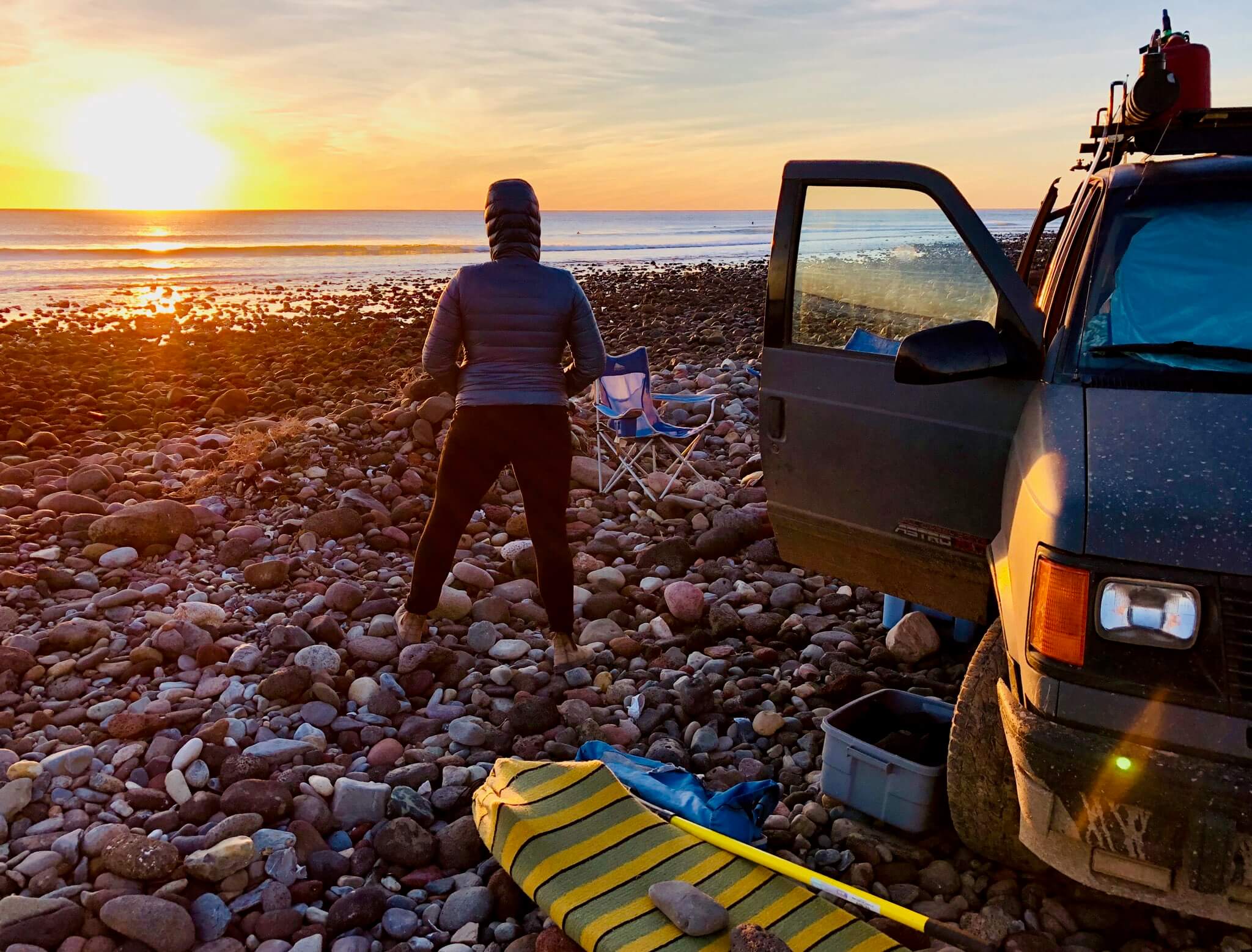
Boundary Waters Wilderness, Minnesota
Kim: Right now we need to be more spread out and distanced from other people. How do you recommend we approach camping if we want to stay socially distanced?
Darcy: I think people need to get creative with the places they go, and it’s not necessarily going to be a quick Google search for “Where can I go camping?” You might need to start digging a little deeper. Go to the 6th page on Google instead of the 1st page and see what you can find. And as Christian said before, get satellite imagery and see what you might find that you might not find by searching on Google.
But if you’re camping outside of campgrounds, make sure you check regulations to make sure that camping is allowed. Also look into where you’re camping and see if you need a fire permit. A lot of times when you’re not in a campground, you can’t have a campfire. Even if you see camp rings, you need to research the laws and get a fire permit, either from a local office or online. Sometimes you even need a fire permit for having a camp stove, so that’s something very important to remember.
Kim: What do you do about going to the bathroom when you’re camping somewhere that’s not a traditional campground without running water?
Darcy: We carry a full-size shovel with us in the van at all times, and we have to find places to go to the bathroom that are outside. When you go number two outside you have to make sure to dig a hole deep enough that it’s not going to harm the environment. It can run off into rivers and streams so you need to make sure that you go far enough away from any sort of water source so that you’re not polluting the water with the runoff from your waste.
You also need to make sure that you dig a hole more than 6 inches deep, which can seem really deep sometimes when the ground is hard. You need to make sure that you don’t leave any sort of toilet paper waste in nature because it doesn’t decompose as fast as you might think it does. You should pack out your toilet paper. That’s the best practice.
Kim: Do you have any recommendations for gear or things you must bring with you if you’re going on a trip that’s a little more remote?
Darcy: Camp chairs, and we have a folding camp table so we can cook on it and hang out outside in comfort.
Christian: I would say you need to have a large container of water. At least 5 gallons of water per day. You have to have a shovel because if you’re going out into the wild you have to bury your poop. I would say that those are probably the two most important things.
Darcy: Don’t forget your lighter to light your stove.
Christian: First-aid kit.
Darcy: Headlamp.
Christian: Extra batteries. Toilet paper. Don’t forget that.
Darcy: Trash bag. Pack out all your trash. Don’t leave any trash around.
Kim: Do you worry about safety when camping in more remote areas?
Darcy: Yeah, there are concerns. I think you go to a place where you feel safest. So if you really want to be safe, you’re better off going to a campground where there might be a campground host. But if you have a little bit more comfort in the outdoors, go for the more off-the-beaten track places.
Christian: But you’re probably safer in areas that there aren’t any people, even though you might not feel safer. You probably actually are because you’re farther away from other people. Wild animals aren’t really going to hurt you.
Darcy: Although, we’ve had a raccoon climb on the top of our van before at night.
Christian: Yeah, that was weird.
Darcy: It was very weird. You hear all this noise and you think it’s someone outside your van, but it’s just a raccoon crawling on your van.
Christian: Yeah, tapping on the roof and stuff.
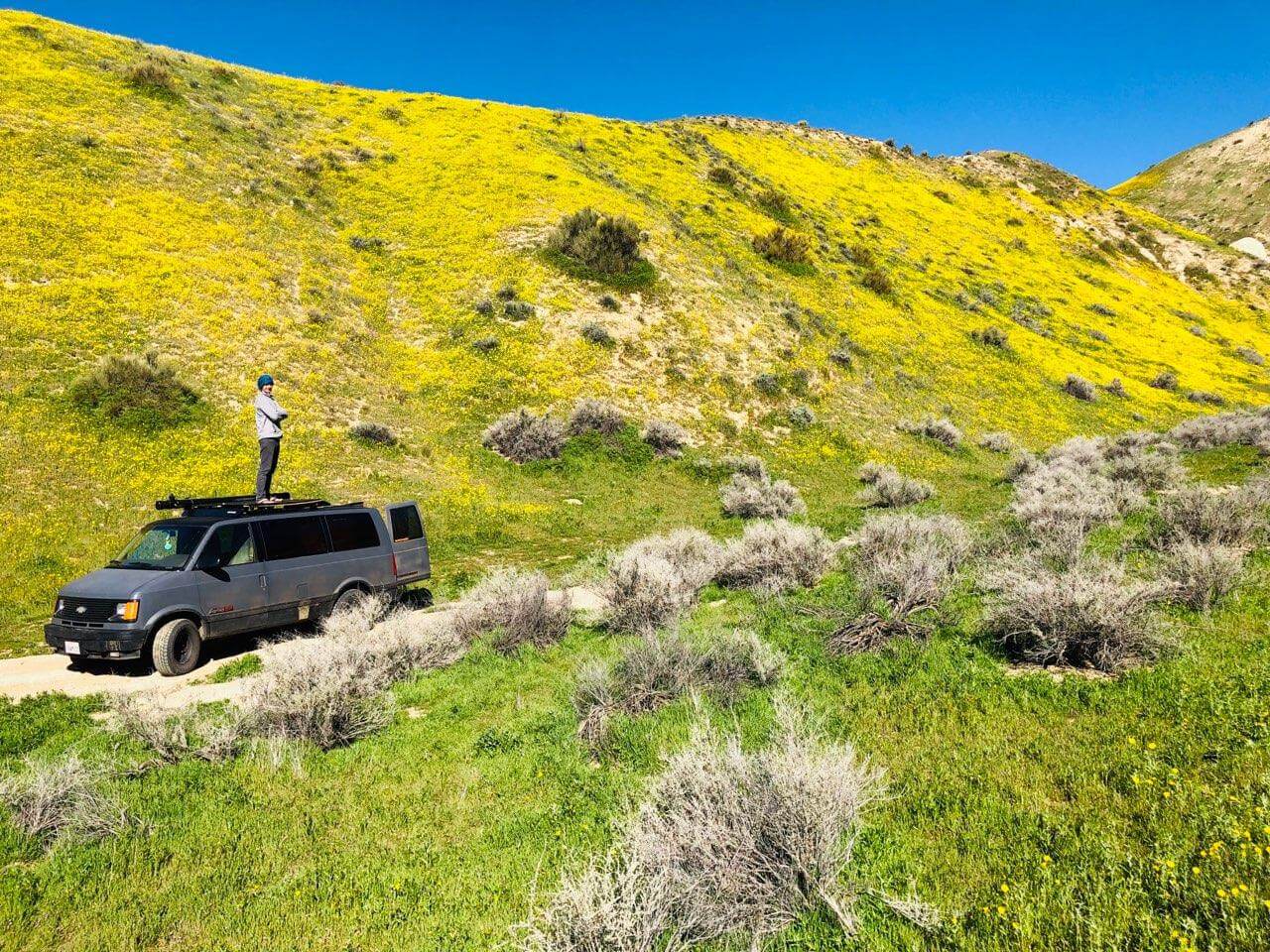
Central Valley, CA
Cody: How do you not get lost in the middle of nowhere?
Darcy: Something that’s really important when you’re going off in the middle of nowhere is downloading the map ahead of time before you lose service. Your phone or device still gets GPS service wherever you are but you have to have the map downloaded before you lose signal. So it’s really important to make sure that wherever you’re going, you download the map for that area so you don’t get lost.
Christian: Download the map!
Kim: You taught me how to make a trip-specific map awhile back. Talk a little bit about how you make your maps for trips.
Darcy: We use Google Maps on our device. We use the same email on all of our devices so we have the same pins and everything. You can find a point and you can put a pin on it. Or let’s say you find a movie theater you want to go to that you can click on the movie theater and [tap] “save,” and then you [pin it with] a heart or a star or a flag, or you can label it. And when we download the map, the pins are there, and we can easily find the places that looked interesting to us when we planned the trip or look for any that might be nearby where we ended up. The pins are saved in your Google profile and they are there forever.
Christian: Then they can track you forever.
Kim: Have you gone on any trips in the van since you had your baby two months ago?
Darcy: We’ve been on two camping trips so far. We got a small, traveling, foldable bassinet for him to sleep in, and we just make sure that we have a good variety of warm and cool clothes for whatever climate we’re going to be in because it can be really hot in the day and cold at night.
Christian: But it’s very difficult.
Darcy: Yeah, it’s difficult. The first time we went, he was 3 weeks old, and the 2nd time we went, he was 5 weeks old. So he was still very new and we’re going to keep trying and see what other tricks we can find to make it easier. Finding a set place to change his diapers [was hard].
Christian: Yeah, it was an experience and we both learned from each other. He learned from us and we learned from him what he likes. Sleeping was a pain in the a**. We didn’t sleep very much at night. In the middle of it we were like, gosh this is really, really hard, are we sure we want to keep doing this?
Darcy: And then we got home and we were glad we did it.
Christian: Yeah, we were very proud of ourselves.
Kim: What’s your favorite camp meal?
Christian: Tacos.
Darcy: If we bring our propane BBQ, we really like to BBQ veggies and meats for tacos. If we don’t have a BBQ, we make a lot of pasta.
Christian: Macaroni and cheese.
Darcy: Macaroni and cheese or pesto pasta.
Kim: Tell me about your favorite experiences in your vans.
Darcy: One of my favorite experiences in the van was when we had the old Escape campervan, actually. We drove to Minnesota and we did the Boundary Waters. We had to put the canoe on the top of the van, and it just looked really rad hauling a canoe on the top of your painted van. I look back at that picture and I have very fond memories of the feeling I had doing that.
Christian: One of my favorite experiences in the van was when I was in Death Valley, just going on all the roads in the backwoods of Death Valley. There are a lot of roads that are off in the middle of nowhere, and it takes you 8 hours to get there, and they’re all washboard and they’re terrible, but then you get to an amazing spot, and it’s like wow, you really journeyed to get there. It’s beautiful out there.
Kim: Have you ever gotten yourselves into trouble in the van?
Darcy: Once we were in Baja, Mexico, and one of our oil lines busted. We were out on a dirt road 30 miles from any building, person’s house, or town, and with our tool box—we were with another friend who had some tools also—we were able to fix the oil line using QuikSteel to fix the oil line on the road. The second time was when we got stuck on a dirt hill, it was the 2-wheel drive Astro Van—this is why we got the all-wheel drive—and the tire was just spinning, and it took about 2 hours to get off the hill.
Kim: Where are you taking the van next?
Darcy: I think we’re going to head up northern California to the Trinity Alps and Mount Shasta area and explore and see what we can find.
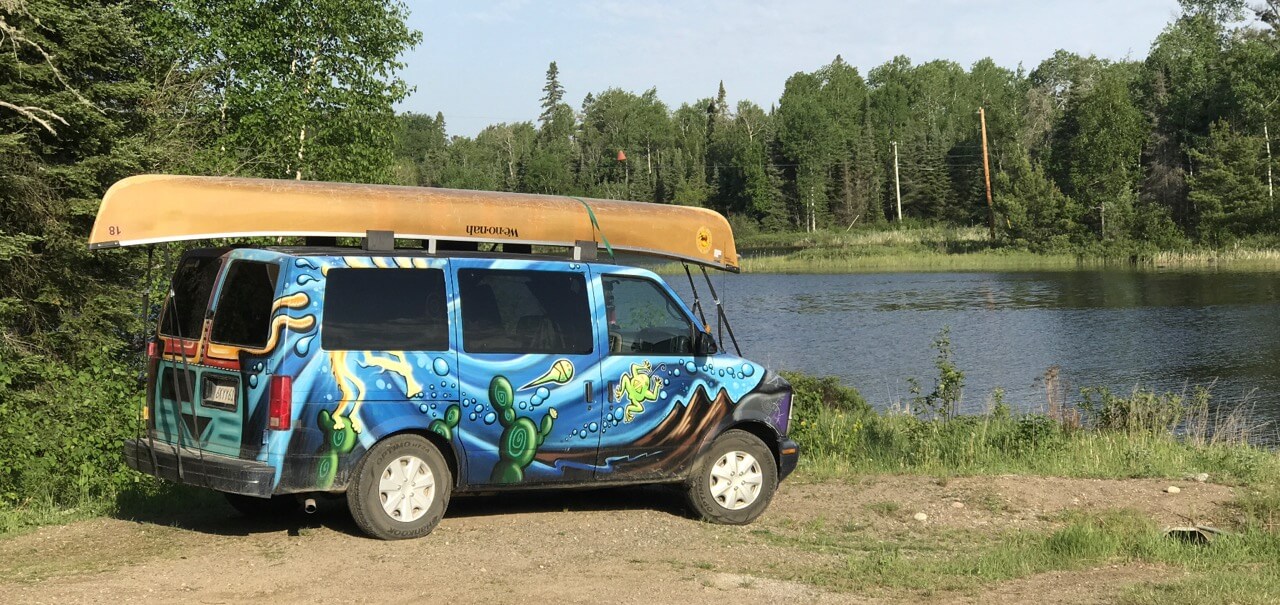
Boundary Waters Wilderness, Minnesota
Kim: Is there anything else you want the Escape Campervan blog readers to know about van life?
Darcy: Enjoy the ride, don’t take anything too seriously, and…
Christian: Respect nature.
Use These Tips And Explore Today!
I’m going to take these tips from Christian and Darcy to get out and explore at a (social) distance this summer. You can, too! Check out @kokovanlife for inspiration, book an Escape Campervan, from one of their many locations and get out on the road less traveled.
